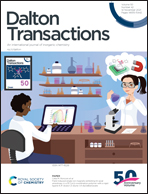The modulation effect of carboxylic acid ligands on the electron transfer photochromism of NDI-derived coordination polymers†
Abstract
Four naphthalene diimide (NDI)-derived coordination polymers (CPs), [Cd(3-DPNDI)(o-BDC)] (1), [Cd(3-DPNDI)2(p-BDC)(NO3)] (2), [Cd(3-DPNDI)(NDC)(H2O)2] (3), [Cd(3-DPNDI)(BPC)(H2O)] (4) (3-DPNDI = N,N’-di-(3-pyridyl)-1,4,5,8-naphthalene diimide, o-BDC = phthalic acid, p-BDC = terephthalic acid, NDC = 2,6-naphthalenedicarboxylic acid, BPC = biphenyl-4,4′-dicarboxylic acid), have been designed and prepared. The usage of carboxylic acid ligands with different sizes, shapes and charge densities leads to the distinct resultant architectures of four CPs and divergent weak interactions (lone pair⋯π, π⋯π and C–H⋯π interactions) of electron donors/acceptors, which further lead to the completely different photoinduced electron transfer (PET) and consequent photochromic properties. More specifically, 1 and 2 display excellent photochromic behaviors with a fast photoresponsive rate and high coloration contrast, which are attributed to the suitable interfacial contacts of electron donors/acceptors. However, 3 and 4 are basically optical inert, which could be attributed to the negative effect of the stronger charge transfer (CT) on PET. The present study illustrates the delicate modulating effect of carboxylic acid ligands on the resultant networks, interfacial relationship and PET together with photoresponsive behaviors.



 Please wait while we load your content...
Please wait while we load your content...